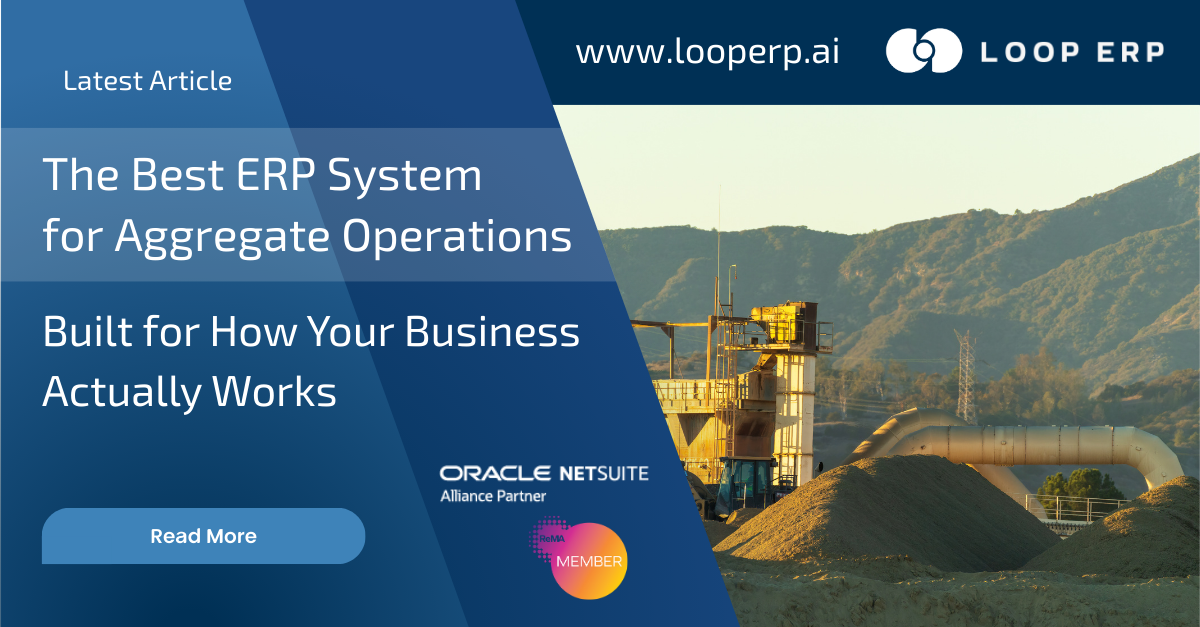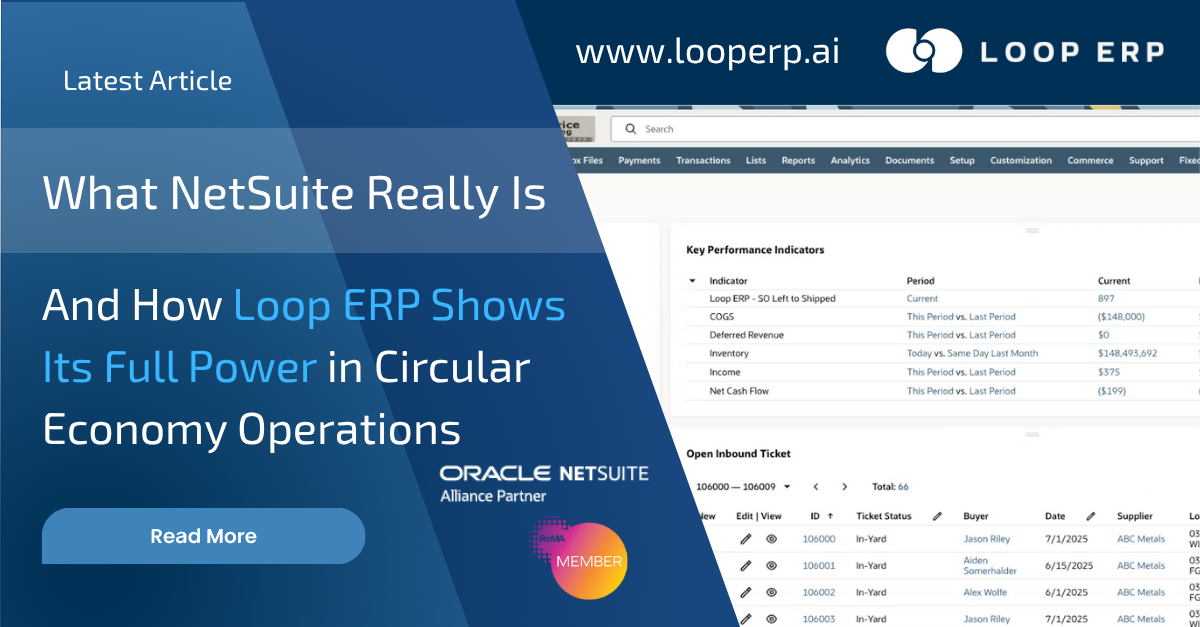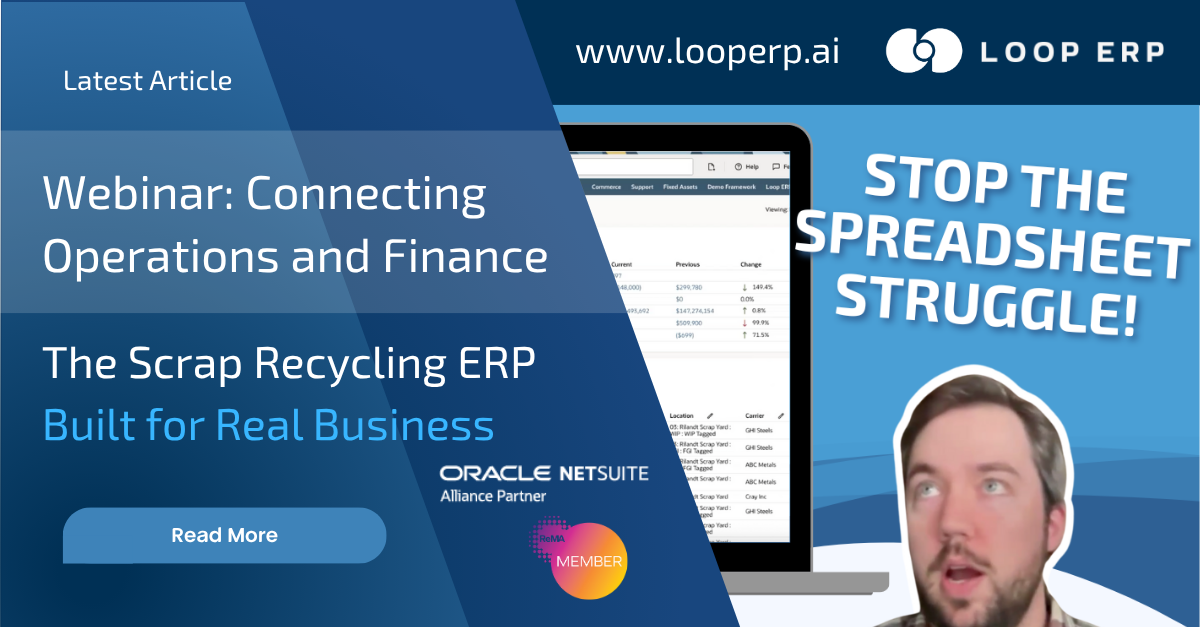
For businesses in the scrap metal, waste management and aggregate supply industries, market volatility isn't just a challenge — it's a fundamental reality. Commodity prices can swing dramatically within days or even hours, transforming profitable materials into break-even propositions or suddenly elevating overlooked resources into high-value assets. In this environment, the difference between thriving and merely surviving often comes down to how effectively a company can respond to these rapid fluctuations.
Commodity transformation businesses face unique volatility challenges that traditional ERP and business management systems simply weren't designed to address. Unlike manufacturers or retailers with relatively stable pricing models, these operations must constantly recalibrate their entire business approach as market conditions evolve.
Most conventional ERP solutions treat pricing as a relatively static variable, with occasional updates flowing through the system at scheduled intervals. This approach works well for businesses selling finished goods with predictable cost structures and market positioning. However, for companies dealing with constantly fluctuating commodity values, this static approach creates significant operational and financial risks:
By the time price updates propagate through traditional systems, market conditions may have already changed again, leading to missed opportunities or losses. This timing gap is particularly problematic in markets where prices can shift multiple times throughout a single trading day. When a metal recycler receives updated pricing at morning, midday, and end-of-day intervals, traditional ERP systems require manual updates that inevitably lag behind market reality. During rapid price movements, this delay can result in purchasing decisions based on outdated values - potentially paying above-market prices during downturns or offering non-competitive rates during upswings that drive away suppliers.
Generic ERP solutions typically can't handle the complex grading variations that determine value in commodity businesses, forcing oversimplified pricing models. In scrap metal alone, copper might be categorized into more than a dozen grades with significantly different values based on purity, form factor, and contamination levels. Standard ERP systems generally support only basic product hierarchies that can't capture these nuanced distinctions. As a result, businesses either maintain pricing information outside the system or implement crude approximations that fail to reflect true market values for specific material variations.
Conventional systems rarely connect directly to market pricing feeds, requiring manual research and data entry that introduces delays and errors. This disconnection forces commodity businesses to dedicate significant staff time to monitoring market publications, websites, and trading platforms - then manually translating those insights into system updates. Beyond introducing delays, this manual process inevitably leads to inconsistencies as different team members interpret market signals differently or prioritize different information sources. The resulting pricing inconsistencies create both operational confusion and financial risks throughout the organization.
Standard inventory valuation methods don't account for the complex transformation processes that can dramatically affect commodity values through separation, purification, or aggregation. Traditional systems typically apply simplistic formulas that fail to capture how material values change throughout processing stages. For example, a mixed electronics load might contain precious metals that are invisible to conventional valuation methods until separation processes are completed. Without specialized valuation capabilities, businesses cannot accurately assess whether processing certain materials is financially justified under current market conditions, leading to suboptimal operational decisions.
These limitations force many commodity businesses to rely on spreadsheets, manual calculations, and tribal knowledge to manage pricing - creating inefficiencies, inconsistencies, and missed opportunities.

Loop ERP was specifically designed to address the unique pricing challenges faced by commodity transformation businesses. Unlike general-purpose ERP systems retrofitted with basic commodity handling capabilities, Loop's architecture places dynamic market responsiveness at its core.
At the center of Loop's volatility management capabilities is a sophisticated formula-based pricing engine that allows businesses to create dynamic pricing relationships instead of static price points. This approach transforms how companies respond to market movements:
Rather than manually updating thousands of individual price points when markets shift, businesses can establish mathematical relationships between published indices and their specific material grades. When index prices change, all related material values automatically recalculate throughout the system - from purchasing to inventory valuation to sales quotes.
These formulas support complex multi-variable calculations that reflect real-world pricing relationships. For example, a metal recycler might establish pricing where:
When commodity indexes update, these formulas instantly recalculate across the entire operation, ensuring all business decisions reflect current market realities.
Loop's system allows businesses to map different material grades to the specific market indices most relevant to their actual trading value. This capability reflects the reality that different commodities and grades respond to different market signals:
This material-specific approach ensures that pricing changes occur only when truly relevant market signals shift, rather than applying blanket adjustments across dissimilar materials.
In volatile markets, treating inventory as a homogeneous pool leaves significant value unrealized. Loop ERP enables sophisticated inventory segmentation strategies that maximize returns throughout market cycles.
Loop's inventory management maintains cost-basis tracking at a highly granular level, preserving the original purchase cost of materials even as they move through transformation processes. This approach enables:
Loop ERP provides the flexibility to select which cost-based materials to sell based on market conditions, rather than forcing rigid inventory accounting methods. During rising markets, businesses can strategically choose to sell older, lower-cost inventory first to maximize margin capture. Conversely, during market downturns, they can selectively sell more recently acquired inventory with higher cost basis to minimize paper losses. This dynamic approach transforms inventory accounting from a back-office function to a strategic tool that directly impacts profitability. Whereas traditional systems force companies to choose a single inventory methodology and apply it universally, Loop allows situation-specific optimization that responds to actual market conditions.
Loop provides accurate tracking for tax-advantaged inventory management approaches that can significantly impact year-end financial outcomes. The system maintains meticulous documentation of acquisition dates, costs, and material transformations that support defensible tax positions. This capability is particularly valuable for businesses that want to minimize taxable gains during strong markets or recognize strategic losses during appropriate fiscal periods. The system's reporting functionality helps finance teams model different inventory valuation scenarios before year-end, enabling proactive tax planning rather than reactive reporting. This financial flexibility becomes especially valuable during periods of extreme price volatility that can create both challenges and opportunities from a tax perspective.
Loop's granular tracking enables the identification of high-margin materials during declining markets when overall profitability faces pressure. By preserving the connection between specific inventory lots and their original acquisition costs, businesses can precisely identify which materials still offer acceptable margins despite market downturns. This visibility allows operations to prioritize selling these higher-margin materials when market conditions deteriorate, rather than blindly following market pricing across all inventory. For businesses managing millions in inventory value, this selective approach can maintain profitability even when broader market conditions turn challenging. Moreover, it prevents the common problem of "blended margin blindness" where overall average margins mask the profit potential of specific inventory segments.
For operations handling thousands of tons of materials with varying acquisition costs, this granularity can mean the difference between profit and loss during volatile periods.
"Commodity businesses must adapt quickly to market volatility. Relying on outdated ERP systems leads to missed opportunities and financial risks. Real-time pricing adjustments and inventory optimization are essential for sustained profitability."
Effective procurement becomes exceptionally challenging during volatile markets, as yesterday's buying parameters may no longer apply to today's conditions. Loop ERP provides specialized tools to maintain procurement profitability despite these fluctuations.
Loop's purchasing module includes dynamic price adjustment capabilities that automatically recalibrate buying parameters based on current market conditions:
Loop implements automatic updates to buying prices based on index movements, ensuring procurement parameters remain perfectly aligned with current market conditions. The system allows businesses to establish specific percentage relationships between published indices and internal buying prices for each material grade. When index prices change, these percentages automatically apply across all buying stations, scales, and purchasing agents without manual intervention. For example, a business might set their #1 copper buying price at 85% of COMEX, automatically adjusting throughout the day as COMEX values fluctuate. This automation eliminates the dangerous lag between market movements and buying price updates that frequently leads to overpaying during downturns or losing supply to competitors during upswings. For high-volume operations, this continuous alignment can represent tens of thousands in saved costs or captured opportunities monthly.
Loop enables different adjustment rates for different quantity levels, allowing sophisticated volume-based purchasing strategies that maximize supplier relationships. The system can automatically calculate different percentage adjustments based on delivery size, rewarding suppliers who provide larger, more efficient quantities. These tiered models might offer 82% of index for small deliveries, 85% for medium loads, and 87% for full truckloads of the same material. This capability helps operations optimize inbound logistics while providing appropriate incentives for suppliers to consolidate deliveries. During volatile markets, these tiered models become even more valuable as they help maintain supply consistency by offering premium rates for volume while protecting margins on smaller, less efficient transactions. The system automatically recalculates all tier thresholds whenever base indices change, maintaining consistent spread relationships regardless of price levels.
Loop supports customized pricing relationships for different supply sources, acknowledging that not all suppliers deliver equal value beyond raw materials. The system allows businesses to establish supplier-specific adjustment factors that reflect quality consistency, delivery reliability, administrative efficiency, or strategic relationship value. These customized parameters might provide premium pricing to suppliers who consistently deliver cleaner material, reliable daily volumes, or complete electronic documentation. During market volatility, these supplier-specific adjustments help maintain critical supply relationships while still allowing base prices to move with market conditions. The system preserves these relationship premiums as percentages or fixed adjustments to base rates, ensuring they remain proportional during significant market fluctuations rather than becoming disproportionately large or small as absolute values change.
These dynamic adjustments ensure that procurement teams never work with outdated pricing guidance, eliminating the risk of overpaying as markets decline or losing supply opportunities when markets strengthen.
Loop implements custom buying parameters based on historical processing results, recognizing that nominal weights often don't reflect actual recoverable value. The system maintains detailed records of processing outcomes for each supplier's materials, calculating average recovery rates and yield percentages across multiple deliveries. These historical performance metrics then automatically factor into future purchasing decisions, creating custom price adjustments that reflect actual recoverable value rather than gross weight. For example, if Supplier A's material consistently yields a 98% recovery rate while Supplier B's similar-looking material yields only 92%, the system automatically offers appropriate price differentials that reflect this performance gap. This yield-based approach transforms purchasing from a simple weight-based transaction to a sophisticated value-based exchange that protects margins regardless of market volatility.
Revenue optimization during volatile markets requires sophisticated approaches that go beyond simply matching current market prices. Loop ERP provides specialized tools that help sales teams maximize returns throughout market cycles.
Loop supports custom pricing relationships that update automatically with index movements, maintaining consistent margin structures regardless of market conditions. The system allows sales teams to establish mathematical formulas that define each customer's unique pricing structure, specifying exact relationships to published indices. When index values change, all customer prices automatically recalculate according to their specific formula, eliminating manual updates and ensuring timely, accurate pricing. These formulas can incorporate multiple variables including processing costs, transportation allowances, and quality adjustments while maintaining proportional relationships as base indices fluctuate. This automation transforms customer price management from a constant scramble of updates and notifications to a systematic, error-free process that preserves relationship integrity even during extreme volatility while ensuring margin structures remain intact.
Loop provides sophisticated analysis of carrying costs versus potential market upside, helping businesses make informed inventory holding decisions. The system calculates comprehensive carrying costs including financing expenses, physical storage costs, insurance, and potential quality degradation for each material category. These costs are then compared against historical price volatility patterns and current market directional indicators to determine whether holding material is economically justified. For example, if a material historically demonstrates 15% monthly price volatility but carries a 2% monthly holding cost, strategic holding during market dips may be financially advantageous. This analysis transforms inventory decisions from gut-feel judgments to economic calculations that balance tangible holding costs against statistically-based potential returns, helping businesses optimize working capital deployment during volatile markets.
Loop enables detailed comparisons of selling materials in current form versus upgrading them first through additional processing steps. The system analyzes current market spreads between different material grades alongside processing costs to determine whether additional transformation would increase net realized value. For example, it might calculate whether the current premium for insulation-free copper justifies the labor cost of stripping insulated wire, or whether the spread between mixed and sorted plastics warrants additional separation processes. This analysis accounts for both direct processing costs and opportunity costs of delayed sales, providing a complete economic picture of transformation decisions. During volatile markets, these spreads between different grades often widen or compress unpredictably, making systematic analysis essential for optimal decision-making rather than relying on historical rules of thumb that may no longer apply to current market conditions.
Effective volatility management requires continuous access to current market information. Loop ERP integrates with key market data sources to maintain a constant flow of pricing intelligence.
Loop implements regular imports based on publication schedules, ensuring system pricing always reflects the latest available market data. The system maintains awareness of when each major price reporting service releases updates - whether hourly, daily, or weekly - and automatically initiates import processes to synchronize internal data with these publications. This scheduled synchronization eliminates the common problem of delayed updates when staff are busy with other priorities or when publications release outside of normal business hours. For organizations relying on diverse price sources with different publication frequencies, this automation ensures all relevant indices remain current without requiring manual monitoring of release schedules. The system maintains detailed logs of all index updates, creating a comprehensive audit trail that documents exactly when new market information became available and was incorporated into operational pricing.
Loop enables immediate updates when significant price movements occur, ensuring rapid response to unusual market conditions. The system can monitor real-time data feeds from exchanges and price reporting services, automatically triggering import processes when prices move beyond specified thresholds. These thresholds can be configured separately for different materials and indices, reflecting the normal volatility patterns of each commodity. For example, a 2% move might trigger an immediate update for relatively stable materials, while more volatile grades might use wider thresholds. This selective approach ensures that truly significant market moves receive immediate attention while avoiding distraction from normal market noise. During periods of extreme volatility, these change-triggered imports provide essential real-time intelligence that keeps operations aligned with rapidly evolving market conditions.
Loop supports simultaneous tracking of multiple relevant indices across diverse publications and exchanges, creating a comprehensive market intelligence dashboard. The system can integrate data from specialized industry publications, major commodity exchanges, regional price reporters, and proprietary information services - all within a unified interface. This multi-source approach overcomes the limitations of relying on any single market indicator, presenting a more complete picture of actual trading conditions across different regions and market segments. For businesses dealing with diverse material streams, this comprehensive view prevents the tunnel vision that can occur when monitoring only primary indices. The system also identifies divergences between different sources tracking similar materials, highlighting potential market inefficiencies or regional disparities that may create trading opportunities.
This automation ensures that all pricing formulas, inventory valuations, and transaction guidance reflect the most current market realities at all times.
In commodity-based businesses, market volatility is inevitable. What's optional is whether your operation will be perpetually reacting to these fluctuations or strategically capitalizing on them.
Loop ERP's specialized tools for managing market volatility transform what many businesses experience as a constant threat into a strategic opportunity. By implementing formula-based pricing, sophisticated inventory segmentation, dynamic procurement strategies, optimized sales approaches, and integrated market intelligence, commodity transformation businesses can achieve a level of market resilience that creates sustainable competitive advantage.
For scrap metal, waste management, and aggregate supply companies seeking to master rather than merely survive market volatility, Loop ERP provides purpose-built capabilities that generic business systems simply cannot match. The question is no longer whether you can afford specialized tools for volatile markets, but whether you can afford to operate without them.
Learn more about Loop ERP's dynamic pricing capabilities by contacting our industry specialists or requesting a personalized demonstration focused on your specific commodity market challenges.
Powerful, self-serve product and growth analytics to help you convert, engage.
Blogs

December 4, 2025
The Best ERP System for Aggregate Operations, Built for How Your Business Actually Works

November 18, 2025
What NetSuite Really Is, And How Loop ERP Shows Its Full Power in Circular Economy Operations

November 7, 2025
Webinar: Connecting Operations and Finance with Loop ERP: The Scrap Recycling ERP Built for Real Business